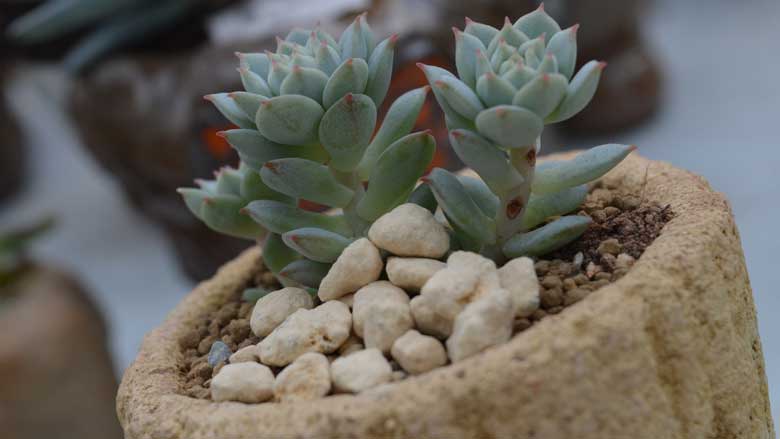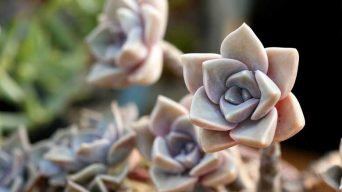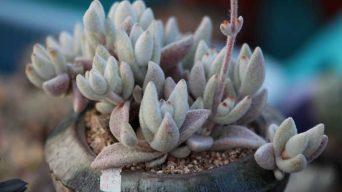To repot succulents, remove them from their current pot, loosen the roots, add new potting soil, and place them in a slightly larger container with drainage holes. Repotting should be done during the active growing season every 3-6 years.
If you have succulents, then at some point, you will need to know how to repot them.
Repotting succulents is a straightforward process, and it’s something that you can do yourself at home with just a few simple supplies.
This article will walk you through the steps involved in repotting succulents.
We’ll also provide tips on caring for your newly repotted plants.
So if you’re ready to learn how to pot succulents, keep reading!
How To Know When to Repot Succulents
One of the first things you need to know before repotting succulent plants is when to do it.
Generally, you should only repot succulents if they are starting to become rootbound.
If you see that the roots of your plants are growing out of the soil and into the pot, then it’s time to repot.
You can also repot succulents if they are not growing as well as you would like them to or if they seem to be losing color or vigor.
If you’re not sure whether or not it’s time to pot your succulents, here are a few signs that will help you decide:
Newly Purchased Succulents
When you first buy succulents, they usually come in plastic containers with a soil mix that is not ideal for succulents.
It’s always recommended to repot succulents just after you buy them to give them a succulent soil mix that suits their needs.
The Plant Has Outgrown Its Current Pot
Succulents will become rootbound when they grow too large for their current pot.
If the roots grow out of the soil and into the pot, or if the plant is starting to take up too much space in its container, it’s time to repot.
The Soil Dries Out Quickly
If the soil in your succulent pot dries out quickly, it’s time to water more frequently.
And if the plant is still not getting enough water despite watering more often, it may be time to repot into a bigger pot.
The Succulent Needs Fresh Soil
If the succulent plant looks sad and you’ve been watering it regularly, it may be time to give it some fresh soil.
Succulents need well-draining soil to thrive, so if the potting mix is starting to look compacted or there are no drainage holes in the pot, then it’s time to repot.
The Plant Is Wilting
If the succulent is wilting, it’s not getting enough water.
But if you’ve been watering it regularly and the plant is still wilting, it may be a sign that the potting mix is too dense and needs more air.
In this case, you should repot the succulent into a pot with better drainage.
The Roots Are Growing Out of the Soil and Into the Pot
If you can see the roots of your succulent plant growing out of the soil and into the pot, it’s time to repot.
This indicates that the succulent has become rootbound and is not getting enough nutrients from its current soil.
The Plant Is Losing Color or Vigor
If the succulent plant isn’t looking as healthy as it once did, or if it’s starting to lose its color, that could be a sign that it needs to be repotted.
This could be due to various reasons, such as a lack of nutrients in the soil or too much moisture.
The Succulent Is Not Growing Well
If the succulent isn’t growing as tall or as large as it should be, that could be a sign that it needs to be repotted.
This may be due to the soil mix being too dense or too wet or the plant’s lack of room to grow.
When Should You Not Repot Succulents?
There are a few situations when you should not repot succulent plants.
- If the plant is in bloom, you should not repot it because doing so could damage the flowers.
- If the succulent is very small or newly transplanted, you should wait until it has grown more before repotting it.
- If the succulent is diseased or has pests, you should take care of the problem before repotting.
- If the succulent grows well and shows no signs of being rootbound, you don’t need to repot it.
When Is the Best Time to Repot Succulents?
The best time to repot succulents is just before their growing season begins. For most succulents, this is in the early spring and summer.
However, some succulents may prefer to be repotted in the late summer or early fall.
This depends on the specific succulent’s growth habits, as some go through a dormant period in the winter, and other succulents will go dormant in the summer.
Repotting succulents before they grow will give them time to recover and establish new roots before the next growing season.
If you repot your succulents late in the growing season, there is a greater chance that they will need more time to recover before the cold weather arrives.
Succulent plants need time to establish new roots and get established before going into a dormant state.
Repotting Succulents in Winter
While it’s best to repot succulents in the spring or summer, you can also repot them in winter.
Just be sure to take extra precautions when repotting succulents in cold weather.
Here are a few tips on how to repot succulents in winter:
- Wait for a warm day to repot the succulents. You don’t want the plants to get too cold during the process.
- Wear gloves to protect your hands from the cold weather.
- Be careful not to damage the roots when repotting.
- Do not water the succulent immediately after repotting. Wait a few days to see how the plant reacts to its new pot before watering it.
- Place the succulent in a location where it will get some indirect sunlight.
- Keep an eye on the plant and ensure it is not getting too cold.
If you follow these tips, you should have no problem repotting your succulents in winter.
Just be sure to take extra care of the plants during this time, and they will be fine.
How Often Should You Repot Succulents?
Generally, you should repot succulents every one to two years. You can help ensure they stay healthy and grow well by repotting them regularly.
However, this depends on how healthy the plant is, how big it is, and if the soil is still in good condition.
If the succulent grows well and shows no signs of being rootbound, you don’t need to repot it.
But if the succulent looks a bit sad and you’ve been watering it regularly, it may be time to give it some fresh soil.
Succulents need well-draining soil to thrive, so if the potting mix is starting to look compacted, repotting will help to refresh the soil and improve the plant’s health.
How to Repot Succulents Step-by-Step
Now that you know when and why to repot succulents, it’s time to learn how to do it.
Here is a simple step-by-step guide on how to repot succulents:
1. Choose the Right Pot
The first step in repotting your succulent is choosing the right pot.
You’ll want to find a slightly larger pot than the current pot with drainage holes in the bottom.
Terracotta or ceramic pots are ideal for succulents, as these materials allow the soil to breathe and help prevent moisture build-up.
But if you don’t have a pot that’s the right size, you can use a plastic pot or even just a recycled container.
Make sure the pot has drainage holes and is large enough to hold the succulent roots.
2. Remove the Succulent From Its Current Pot
The next step is to remove the succulent from its current pot.
If the plant is rootbound, you may need a knife or scissors to cut away some of the roots before removing them from the pot.
Be careful not to damage the roots too much, as they will need them to anchor the plant in its new pot. Just loosen the soil around the roots and gently pull the plant out of the old pot.
3. Loosen the Soil
Once you’ve removed the succulent from its pot, it’s time to loosen up the soil.
Use your fingers or a spoon to break up any clumps of soil and loosen the roots.
Remove as much of the old soil as possible without damaging the roots.
4. Inspect the Roots
Now that the soil has been loosened look closely at the roots.
If they are damaged or unhealthy, you may need to trim them before planting them in the new pot.
Avoid cutting off too much of the root system, as succulents rely on their roots to uptake water and nutrients.
Just trim off the damaged or unhealthy roots and discard them.
5. Add Some Fresh Soil to the New Pot
Once you’ve prepared the new pot and inspected the succulent roots, it’s time to add some fresh soil.
Succulent plants need well-draining potting soil to thrive, so make sure to use a potting mix specifically designed for succulents.
A cactus soil mix or a succulent soil blend with sand and perlite will work well.
Add enough potting soil to the pot to cover the succulent roots, but don’t pack it down too much.
6. Place the Succulent in the New Pot
Now that the soil is in place, it’s time to put the succulent in its new pot.
Gently nestle the plant into the soil and ensure the roots are covered.
Center the succulent in the pot and make sure that it is stable. If needed, add more soil, but be careful not to pack it down too much.
7. Don’t Water the Succulent Yet
Now that the succulent is in its new pot don’t water it yet.
Wait at least a week to allow the roots to become re-established in their new soil.
After a week, you can begin to water the plant regularly again.
How To Care for Newly Repotted Succulents
Now that you know how to repot succulents, you must understand how to care for them afterward.
Here are a few tips on how to care for newly repotted succulents:
- Don’t water the plant until the soil has had a chance to settle. Wait at least a week before watering the succulent.
- Don’t overwater the succulent. Succulents need well-draining soil, so ensure to only water them when the soil is dry to the touch.
- Be careful to avoid exposing the succulent to direct sunlight right after repotting. The plant needs time to adjust to its new pot and may get sunburned if you don’t wait a few days.
- Place the succulent in a location where it will get some indirect sunlight. This will help the plant adjust to its new pot and grow healthy and strong.
- Keep the succulent in a cool, dry place until it can adjust to its new pot. You can then move the succulent back to its usual location.
- Check the succulent for pests and diseases regularly. If you notice any trouble, take action immediately to treat the plant.
Be patient! The succulent may take a few weeks to grow new leaves and branches.
But if you care for it properly, it will eventually recover and look beautiful again.
Final Thoughts
If you have a succulent looking a bit scraggly or has outgrown its current pot, repotting it is the solution.
Repotting succulents is relatively straightforward as long as you are careful and patient.
Following the steps outlined in this article, you can successfully transplant your succulents into new pots and keep them healthy and thriving.







